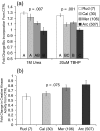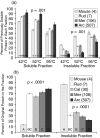Superior proteome stability in the longest lived animal
- PMID: 24254744
- PMCID: PMC4082568
- DOI: 10.1007/s11357-013-9597-9
Superior proteome stability in the longest lived animal
Abstract
Bivalve mollusks have several unique traits, including some species with exceptionally long lives, others with very short lives, and the ability to determine the age of any individual from growth rings in the shell. Exceptionally long-lived species are seldom studied yet have the potential to be particularly informative with respect to senescence-resistance mechanisms. To this end, we employed a range of marine bivalve mollusk species, with lifespans ranging from under a decade to over 500 years, in a comparative study to investigate the hypothesis that long life requires superior proteome stability. This experimental system provides a unique opportunity to study closely related organisms with vastly disparate longevities, including the longest lived animal, Arctica islandica.Specifically, we investigated relative ability to protect protein structure and function, both basally and under various stressors in our range of species. We found a consistent relationship between species longevity, resistance to protein unfolding, and maintenance of endogenous enzyme (creatine kinase) activity. Remarkably, our longest-lived species, Arctica islandica (maximum longevity >500 years), had no increase in global proteome unfolding in response to several stressors. Additionally, the global proteome of shorter-lived species exhibited less resistance to temperature-induced protein aggregation than longer-lived species. A reporter assay, in which the same protein's aggregation properties was assessed in lysates from each study species, suggests that some endogenous feature in the cells of long-lived species, perhaps small molecular chaperones, was at least partially responsible for their enhanced proteome stability. This study reinforces the relationship between proteostasis and longevity through assessment of unfolding, function, and aggregation in species ranging in longevity from less than a decade to more than five centuries.
Figures




Similar articles
-
Resistance to genotoxic stresses in Arctica islandica, the longest living noncolonial animal: is extreme longevity associated with a multistress resistance phenotype?J Gerontol A Biol Sci Med Sci. 2013 May;68(5):521-9. doi: 10.1093/gerona/gls193. Epub 2012 Oct 10. J Gerontol A Biol Sci Med Sci. 2013. PMID: 23051979 Free PMC article.
-
Age-related cellular changes in the long-lived bivalve A. islandica.Age (Dordr). 2015 Oct;37(5):90. doi: 10.1007/s11357-015-9831-8. Epub 2015 Aug 29. Age (Dordr). 2015. PMID: 26318854 Free PMC article.
-
Longevity and GAPDH Stability in Bivalves and Mammals: A Convenient Marker for Comparative Gerontology and Proteostasis.PLoS One. 2015 Nov 30;10(11):e0143680. doi: 10.1371/journal.pone.0143680. eCollection 2015. PLoS One. 2015. PMID: 26619001 Free PMC article.
-
Masters of longevity: lessons from long-lived bivalves--a mini-review.Gerontology. 2010;56(1):55-65. doi: 10.1159/000221004. Epub 2009 May 26. Gerontology. 2010. PMID: 19468199 Review.
-
Methusaleh's Zoo: how nature provides us with clues for extending human health span.J Comp Pathol. 2010 Jan;142 Suppl 1(Suppl 1):S10-21. doi: 10.1016/j.jcpa.2009.10.024. Epub 2009 Dec 4. J Comp Pathol. 2010. PMID: 19962715 Free PMC article. Review.
Cited by
-
Comparative studies of mitochondrial reactive oxygen species in animal longevity: Technical pitfalls and possibilities.Aging Cell. 2019 Oct;18(5):e13009. doi: 10.1111/acel.13009. Epub 2019 Jul 19. Aging Cell. 2019. PMID: 31322803 Free PMC article. Review.
-
How to Slow down the Ticking Clock: Age-Associated Epigenetic Alterations and Related Interventions to Extend Life Span.Cells. 2022 Jan 29;11(3):468. doi: 10.3390/cells11030468. Cells. 2022. PMID: 35159278 Free PMC article. Review.
-
Nucleolar TFIIE plays a role in ribosomal biogenesis and performance.Nucleic Acids Res. 2021 Nov 8;49(19):11197-11210. doi: 10.1093/nar/gkab866. Nucleic Acids Res. 2021. PMID: 34581812 Free PMC article.
-
Comparative Analysis of Mammal Genomes Unveils Key Genomic Variability for Human Life Span.Mol Biol Evol. 2021 Oct 27;38(11):4948-4961. doi: 10.1093/molbev/msab219. Mol Biol Evol. 2021. PMID: 34297086 Free PMC article.
-
Integrating cellular senescence with the concept of damage accumulation in aging: Relevance for clearance of senescent cells.Aging Cell. 2019 Feb;18(1):e12841. doi: 10.1111/acel.12841. Epub 2018 Oct 22. Aging Cell. 2019. PMID: 30346102 Free PMC article. Review.
References
Publication types
MeSH terms
Substances
Grants and funding
LinkOut - more resources
Full Text Sources
Other Literature Sources
Medical
